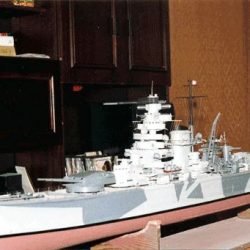Decision on the structure of the ship being supposed to replace the old battleship „Lothringen” approved Reichstag in 1930 with little majority of votes. Contract for construction of the individual which received the temporary marking „Panzerschiff B Ersatz Lothringen”, they granted the Reichmarinewerft shipyard in Wilhelmshaven. The keel up to the individual was put 25 June 1931. The splashdown took place 1 April 1933. That day they named the individual „Admiral Scheer”, and a daughter of the admiral was a godmother, of which name a ship was named. An outbreak of war found the ship in Wilhelmshaven, where 4 September for the first time was bombed by planes of Reefs.However the German individual suffered no damage. From 1940 to 1 April 1941 underwent so-called war rallyes on the Atlantic and Ocean Indian. 1 November reached the north Atlantic. There after five days he came across the HX-84 convoy swimming from Halifaxu in New Scotland which was shielded only by the HMS auxiliary cruiser „Jervis Bay”. Captain of the cruiser Edward Fegen made decisions about the defence and firing at the German cruiser. „Admiral Scheer” opened fire immediately around one’s department of calibre of 280 mm. In the distance of 10 Mm a fight, as a result of which the auxiliary cruiser after 22 minutes sank ensued. At that time the convoy managed oneself enough to disperse the German from 37 ships found the cruiser 6 and sank 5.
In December 1940 stayed directed on into the south Atlantic but in February 1941 reached to Seychelles, there mistook Royal Navy pursuers and 1 April 1941 reached Kiel. During this rally essentially he sank 16 ships about the total capacity 113,000 BRT. from September 1941 of the Baltic Fleet composed of acted on, obstructing the Soviet jacket. In 1942 he was stationed in Norway and acted in the North. Among others he participated in the Wunderland operation, for which paralysing the Soviet navigation on Arctic waters was a purpose.
He stayed in 1943 at sea Baltic. In October 1944 the ship backed up with the fire of its artillery fighting on the peninsula with the Sec.? rve German branches. In it also a time was attacked repeatedly by Soviet aviation, however suffering no damage. The German ship supported fighting armies offshore to March 1945, when had to withdraw it oneself from the fight from the reason rozkalibrowania of intensively used artillery. In order to restore the battle fitness for the individual, she was sent for the repair to Kiel.
9 April 1945 the cruiser went down (for the 22.45 hr), sunk with aircraft bombs in the basin of the Deutsche Werke shipyard in Kiel. He was knocked over bottom up partly scrapped, (to July 1945 non-ferrous metals were extracted), the rest of the wreck was filled in with rubble and the earth.
The ship’s bell is up till today in a Museum of the Jacket in Wilhelmshaven.
German pocket armadillo from the World War II. Ship made of plastics, wood and metal.
TECHNICAL SPECIFICATIONS OF MODEL:
SCALE: 1:100
LENGHT: 186 cm
WIDTH: 21,6 cm


